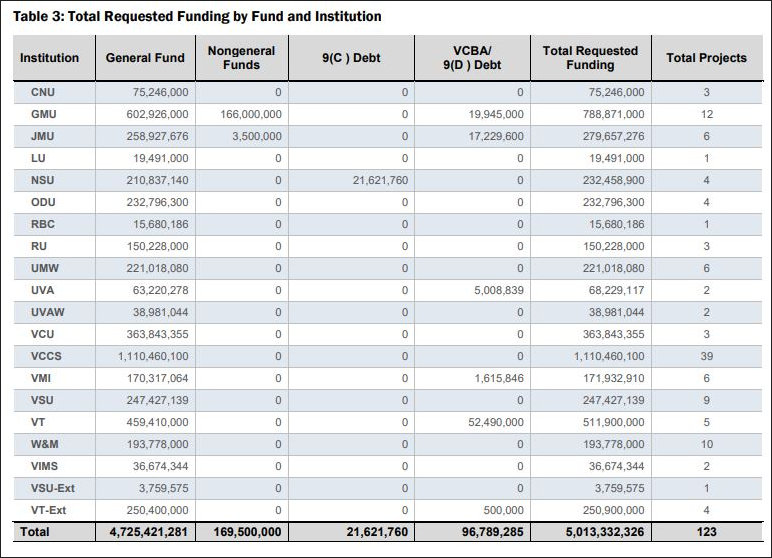With all the hungry piggies pushing for mo’ state money, the feeding trough is getting crowded. Besides the K-12 piggy (squealing for an extra $950 million), the Virginia Retirement System piggy (an extra $215.6 million), and the monstrous Medicaid piggy (the sky’s the limit — how much money do you have?), we can add the higher-ed piggy. A State Council for Higher Education of Virginia (SCHEV) report concludes that the Commonwealth’s public colleges and universities need an additional $212 million in the next biennial budget for operations and financial aid, and $826 million for capital outlays.
Here’s a breakdown of the operational funding needs:
- Affordability and excellence ($113.5 million): Cover growth in operational costs at public institutions; expand need-based financial aid for low- and middle-income students; and increase the Tuition Assistance Grant program to students attending private, nonprofit institutions.
- Access and success ($73.3 million): Improve information and resources available to students; increase funding for Virginia’s community colleges; and invest in programs to improve access and completion.
- Talent development ($18.7 million): Build on a statewide internship program; support investment in instruction-related and research equipment; increase funding to support the Tech Talent Investment Program; and improve the alignment between institutional programs and workforce shortages.
- Efficiency, effectiveness and planning and other areas of support ($6.9 million): With the goal of supporting “more stable tuition and fees growth in the coming years,” review costs and funding models, consider building funding reserves, and support agency efforts and collaborative initiatives.
And here’s a breakdown of capital funding requests by institution:

Here’s what SCHEV is asking of the higher ed institutions themselves:
Yup, that’s a goose egg.
The Council resolution includes the following verbiage: “Whereas, Virginia’s higher education system is a shared responsibility of the state, institutions and students and parents to reach the highest level of performance and accountability…”
The SCHEV report focuses almost exclusively on the state’s responsibilities, and gives almost zero attention to the institutions’ responsibilities.
SCHEV’s proposals do give a nod to “efficiency, effectiveness and planning.” The recommendations propose $150,000 annually for two years to contract with an outside consultant to provide a comprehensive “efficiency and effectiveness” review of structures, processes, policies and outcomes. As an example of the kind of study it has in mind, the report cites a University System of Maryland study that identified “cost avoidance, cost savings, revenue, and strategic reallocation,” which yielded $356 million in savings over 10 years.
The paltry magnitude of the savings — averaging $35.6 million per year — indicates, however, that the review did not address the fundamental drivers of runaway spending such as administrative bloat, gold-plating of facilities, or declining faculty productivity. In other words, SCHEV is asking for money to spend two years studying items that, some time in the future, might yield some marginal savings but require no painful self-examination by the colleges and universities.
“Responsibilities” appear to be a one-way street. Students and parents are responsible for higher tuition, taxpayers are responsible for more in state support, and the universities continue to grow with minimal accountability.



Leave a Reply
You must be logged in to post a comment.